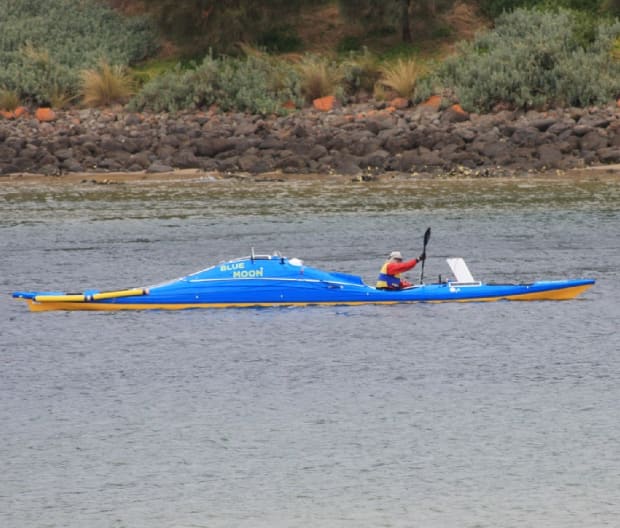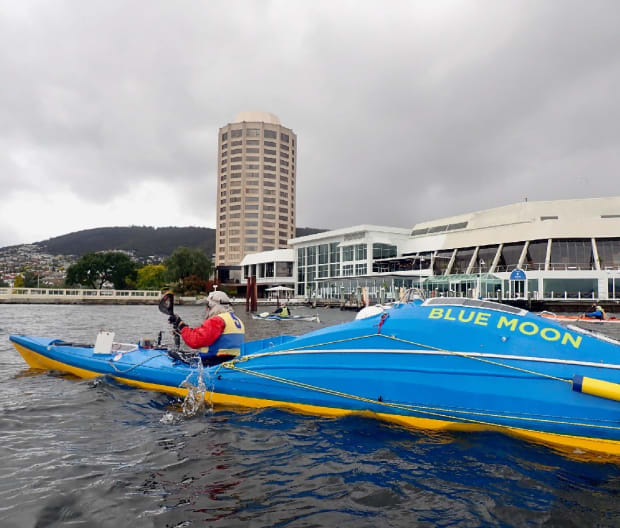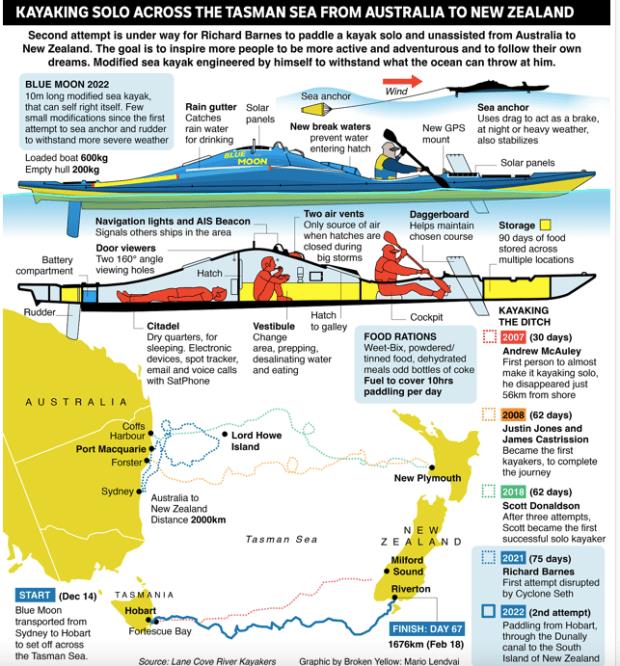After over two months and 2,000 treacherous kilometers, Aussie kayaker Richard Barnes completes one of the world’s most perilous paddling feats.
Sixty-seven days—but’s who’s counting? Richard Barnes sure was, as that’s how many Earth rotations it took for him to kayak the treacherous Tasman Sea solo from Hobart, Australia to New Zealand. The dogged Australian paddler completed his arduous 2,000-kilometer journey on Feb. 18, 2023.
This was Barnes' second attempt at the crossing. The first came in 2021 when he had to give up after 75 days due to bad weather in the form of Cyclone Seth. His most recent crossing makes him only the second solo kayaker to ever paddle the gauntlet (after Scott Donaldson in 2018), and the first person to do so solo, non-stop, and unassisted. (Donaldson’s crossing included a stop at Lord Howe Island and a resupply.)
Related: Ocean Rower Fiann Paul Completes Most Grueling Expedition
The notorious stretch was first crossed non-stop and unassisted in a double kayak by James Castrission and Justin Jones in 2008, just a year after solo sea kayaker Andrew McAuley died during his attempt, with his kayak found less than 30 miles off the New Zealand coast.
A mechanical engineer, Barnes made the journey in a custom-built, self-righting, 32.5-foot-long kayak lovingly called Blue Moon. It comprises three compartments: one for sleeping and drying clothes; one for eating and changing; and the cockpit for paddling. The craft weighed 1,350 pounds when he set off on the journey.
Weather, he admits, played a big role in his success this time around.
Related: The Ultimate Way to Explore Norway’s Fjords Is by Bike
“I had expected to experience more intense, bigger storms than I did on my first attempt,” he tells Men’s Journal. “But really, they were only about the same size. The hardest parts came from dealing with some of the trip’s many challenges, like losing the sea anchor and damaging the rudder. But I found ways to overcome those setbacks.”

Courtesy Image
He admits to a massive, breaking wave also slamming into him once, causing one of two capsizes. “It happened while I was paddling and I got thrown out of the cockpit,” he says. “Another capsize came while I was sleeping. I was thrown around cabin a bit, clanging my head on the electrical box.”
Fortunately, he had a self-righting kayak, as well as the skills and stamina to persevere. A member of Australia’s Lane Cove River Kayakers paddling club, which tracked his progress on the expedition, Barnes, 62, started kayaking when he was 12 with his local Scouts troop back in the ‘70s.
Related: Cyril Derreumaux Kayaks 2,400 Miles Across the Pacific—Solo and Unsupported
He then joined the Sydney University canoe club, further honing his skills by playing canoe polo. Barnes is also an accomplished whitewater and slalom kayaker, paddling rivers throughout Australia, New Zealand, Chile, Ecuador, and Nepal. As for time in the flatwater trenches, which the Tasman Sea crossing had in spades, he’s competed in more than 40 Hawkesbury Classics, a 111-kilometer flatwater marathon Down Under, as well as 20 Massive Murrays, a five-day, 415-kilometer race in Australia.
Still, this was the longest trip he’s ever undertaken. “I did the Yukon 1000 race once, which was 1,600 kilometers, but that was only ten days, not 67,” he says. “I haven’t done any ocean trip longer than 40 days offshore previously.”

Courtesy Image
While he battled constant headwinds and waves (some of which forced him to strap himself to his bed), this time he set off on a different, more southerly route than his first attempt—paddling from Hobart, Tasmania, to a town called Riverton, on New Zealand’s South Island.
Related: Is the Baja 1000 the World's Most Brutal Race? A Top Team of UTVers Makes the Case
A typical day, he says, involved waking up soon after sunrise to pack away his sleeping bag and rearrange the gear in his “bedroom” space. Then he’d have a quick breakfast of Weet-Bix and flatbread in his vestibule. Then he’d begin his “wet” preparation, involving wriggling into his paddling gear before putting his centerboard in place and retrieving his sea anchor.

Land Cove River Kayakers
“Then I’d paddle the day away, usually from around 10 a.m. to 7 p.m., taking breaks generally on the hour, either to change layers, eat a snack, or take a photo,” he says.
Once the day’s paddling was done, he’d slither back into his cabin while there was still light to pack up the cockpit. Spending two hours every other night desalinating sea water, he’d try to enjoy the evening, eating dinner and writing in his diary. He’d hit his sleeping bag around midnight every night and then wake up and do it all over again. Breaks in the routine came from calamities (like that broken rudder), marine life sightings (like some whales that gave him a show) and even his 62nd birthday, which he celebrated with tinned frankfurters—“as close as I could get to hot dogs”— and Pringles.
After 67 days of this, he spotted land for the first time: New Zealand.
“It was pretty emotional when I first saw land—a piece of Stewart Island—but was still some days away from landing,” he says. “That was when it felt like success might be achievable. But I was also very conscious of Andrew McAuley, who had died on the crossing after getting just as close.”
Related: Dispatches: A Bold Sea Kayak Expedition Around New Zealand’s Wild and Barren Stewart Island
At the finish, “It was wonderful to be reunited with family and friends,” he says—adding that “the only the dilemma at this point was juggling who to talk with first.”
Read Barnes’ blog posts here.
-----------------------------
By: Eugene Buchanan
Title: Richard Barnes Completes Solo Kayak Crossing of Tasman Sea
Sourced From: www.mensjournal.com/adventure/richard-barnes-kayaks-solo-across-tasman-sea
Published Date: Fri, 03 Mar 2023 23:19:02 GMT
Did you miss our previous article...
https://conservativedailytimes.com/health-fitness/ice-drifting-polestars-electric-concept-car
.png)





